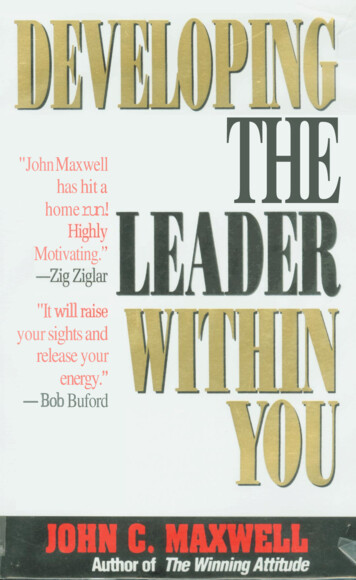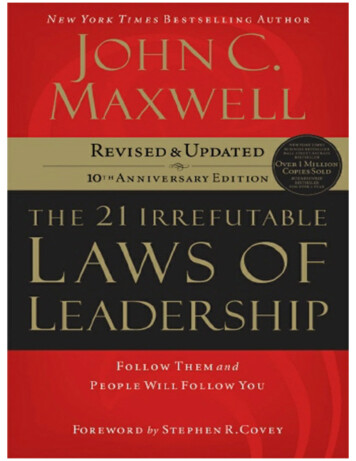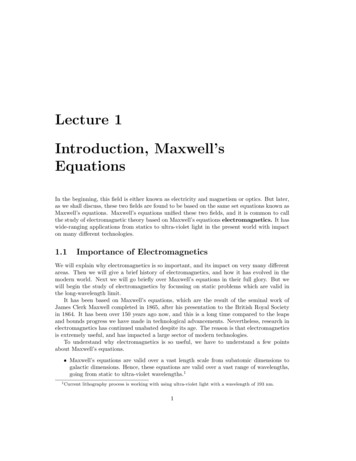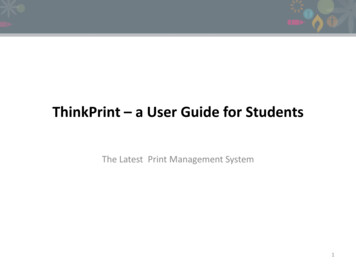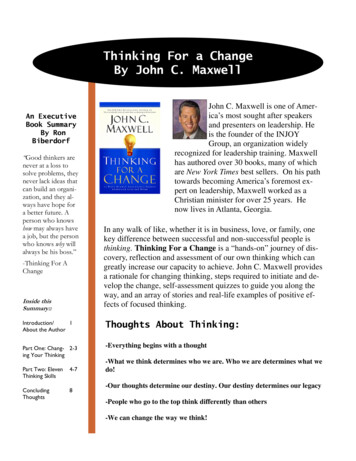
Transcription
Sample ReportStyle: Establisher DMaxwell DISC Personality Indicator ReportTuesday, October 16, 2018 2018, PeopleKeys, Inc. Page 1 / 31
Maxwell DISC Personality IndicatorReportCongratulations on completing your Maxwell DISC Personality Indicator Report! This report will provide you with powerful insight intoseveral important areas in which your natural style presents itself in your personal and professional life.In John Maxwell’s book, The 15 Invaluable Laws of Growth, the Law of Awareness states, “You must know yourself in order to growyourself.” This Maxwell Method report is designed to help you better know yourself, as well as provide you with insight on how you cangrow yourself.This report is based on the DISC methodology of human behavior. Dr. William Moulton Marston, while at Harvard University in the 1920’s,developed the DISC Theory while doing research for his book, The Emotions of Normal People. When his research was complete, theDISC Theory was formed into a validated and reliable assessment for personal and professional development. DISC is the methodologyused in this report to help you identify four different dimensions of your design:Your Behavior Style, Your Communication Style, Your Strength Style, and Your Work Style.You will see on the front cover of your report, just below your name, a descriptive name for your report style. Since each of us, to varyingdegrees, are a combination of the 4 primary DISC types, your style descriptive name may be immediately followed by 1, 2, or 3 of theother DISC letters.While you are able to see the explanation of your DISC profile and how it presents itself in each of the above four style areas, your JohnMaxwell Team Coach will be better able to guide you through using this design combination to help you gain the most insight into thisreport and maximize how you can better know yourself and grow yourself.Now, let’s begin the journey into your personal design. The next two pages provide you an introduction into the four DISC types, severalkey traits for each type, and your DISC graphs. Your John Maxwell Team Coach, Speaker, and Trainer can provide you with the contextfor each graph."Personal growth increases hope. It teaches us that tomorrow can be better than today." John C. Maxwelll 2018, PeopleKeys, Inc. Page 2 / 31
IntroductionSample ReportYour report uses the DISC Personality System. The DISC Personality System is the universal language of behavior. Research has shownthat behavioral characteristics can be grouped together in four major groups. People with similar styles tend to exhibit specific behavioralcharacteristics common to that style. All people share these four styles in varying degrees of intensity. The acronym DISC stands for thefour personality styles represented by the letters :D Dominant, DriverI Influencing, InspiringS Steady, StableC Correct, CompliantKnowledge of the DISC System empowers you to understand yourself, family members, co-workers, and friends, in a profound way.Understanding behavioral styles helps you become a better communicator, minimize or prevent conflicts, appreciate the differences inothers and positively influence those around you.In the course of daily life, you can observe behavioral styles in action because you interact with each style, to varying degrees, everyday.As you think about your family members, friends and co-workers, you will discover different personalities unfold before your eyes.Do you know someone who is assertive, to the point,and wants the bottom line?Some people are forceful, direct, and strong-willed.This is the D StyleDo you have any friends who are great communicatorsand friendly to everyone they meet?Some people are optimistic, friendly, and talkative.This is the I StyleDo you have any family members who are goodlisteners and great team players?Some people are steady, patient, loyal, and practical.This is the S StyleHave you ever worked with someone who enjoysgathering facts and details and is thorough in allactivities?Some people are precise, sensitive, and analytical.This is the C Style 2018, PeopleKeys, Inc. Page 3 / 31
Sample ReportThe chart below helps put the four dimensions of behavior into perspective.D DominantI InfluencingS SteadyC atientInsensitivePoor ListenerLack of DetailShort Attention SpanLow Follow-ThroughOversensitiveSlow to BeginDislikes iveSpontaneousConferringMethodicalBecause human personality is comprised of varying intensities of the four behavioral styles, the DISC graph helps make the personalitystyle more visual. The DISC graph plots the intensity of each of the four styles. All points above the midline are stronger intensities, whilepoints below the midline are lesser intensities of DISC characteristics. It is possible to look at a DISC graph and instantly know thepersonality and behavioral characteristics of an individual.Below are your three DISC graphs, and a brief explanation of thedifferences between the graphs.DISC graph 1 represents your "public self" (the mask)This graph displays the “you” others see. It reflects how you perceive the demands of your environment, and your perception ofhow you believe others expect you to behave.DISC graph 2 represents your "private self" (the core)This graph displays your instinctive response to pressure, and identifies how you are most likely to respond when stress ortension are present. This would be your instinctive reaction.DISC graph 3 represents your "perceived self" (the mirror)This graph displays the manner in which you perceive your typical behavior. It could be referred to as your self perception.Although at times you may be unaware of the behavior you use with other people, this graph shows your typical approach. 2018, PeopleKeys, Inc. Page 4 / 31
Your Behavioral StyleThis section of the report provides you with insight into your DISC behavioral style. This is sometimes referred to as your “personalitystyle.” It helps you better understand your preferred and predictable behavior in your environment and when you interact with others.KNOW YOURSELFThe next page will give you a fun look into some famous people in history who share your behavioral style.Then, you will see a description of your personal behavioral style. You will find a general explanation, along with insight into whatmotivates you and your preferred ideal environment. The general characteristics are a great summary of your style. You will want to paycareful attention to the sections on “motivated by” and “ideal environment.” Understanding your motivation will help provide clarity onwhat will empower you to sustain interest and focus. Understanding your ideal environment will help you discover and align with thesurroundings needed for you to bring your best work forward.GROW YOURSELFAs you read through your style description, create a list of questions for your John Maxwell Team Coach so they can add more value toyou and this experience. Especially make notes on the key points found in the blue boxes.John Maxwell says that, “Success is knowing yourself and your purpose in life, growing to reach your maximum potential, and sowingseeds that benefit others.” You will want to focus effort in those particular areas to be more successful.Here are a few John Maxwell growth programs that will help you be more proactive in that journey to success.How to Be a Real Success – Success is not a destination; it is a process. In this program, you will learn the keys you need to succeed. Nomatter what role you are in, you will achieve great things by understanding four very important success-building areas: Relationships,Equipping, Attitude, and Leadership.Becoming a Person of Influence – Positively impact the lives of others! Whatever your vocation or aspiration, you can increase yourimpact on others by becoming a person of influence. In this program, you will learn simple and insightful ways to interact more positivelywith others. Your personal and organizational success will go off the charts.Put Your Dream to the Test – What do you need to make your dreams come true? Your dream has power. It can inspire and empoweryou, but can it reward you? Your John Maxwell Team member will show you how to crystallize your vision and galvanize yourcommitment.Intentional Living - Deep down, what does every person want most? To live a life that matters. We all want to feel like the time we spenton earth made a difference. How do we achieve that? John Maxwell believes the answer is intentional living. John says, “When youintentionally use your influence every day to bring about positive change in the lives of others, you achieve significance.” There is a bigdifference between a life of good intentions and an intentional life.Your John Maxwell Team Coach can provide you more information on accessing these opportunities and resources. 2018, PeopleKeys, Inc. Page 5 / 31
Historical CharactersSample ReportFamous people who share your personalityJulius Caesar101-44 BCRoman Emperor and GeneralThe driving and individualistic nature of the Establisher is seen in Caesars response to thechallenge of being kidnapped as a young lad of twenty-three. As soon as the ransom was paid,he recruited an army, sought out the pirates and killed them. Remember, Establishers like to win.Now, as the general of an army, he turned his forces against Romes enemies, winning severalbrilliant victories, especially in Gaul and Spain. Establishers are opportunity creators, and Caesarwas interested in political power. To that end he formed an alliance with two other leadingRomans in order to take command of Rome. However, Establishers often find partnershipsdifficult, and Caesar was no exception. His triumvirate did not survive the civil war whichfollowed; but Caesar did. His tremendous victory over Pompeian forces won him the title Dictatorfor Life. Unfortunately for Caesar, that was not a very long period of time. He was assassinatedby the complicity of Brutus, Cassius and the Senate of Rome."It is easier to find men who will volunteer to die, than to find those who are willing to endurepain with patience."Simon Bolivar1783-1830South American Liberation LeaderThe drive and determination to establish freedom has made Bolivar the national hero ofVenezuela, Colombia, Ecuador, Peru, and Bolivia. In 1819, he led his army across the Andesmountains into Columbia. Once there, he proclaimed and became president of the Republic ofColombia (modern Colombia, Venezuela, and Ecuador), which was liberated by his army threeyears later. He then took charge of Perus War for Independence. In their gratefulness, thePeruvians renamed a portion of their country Bolivia in his honor."He who serves a revolution ploughs a sea." 2018, PeopleKeys, Inc. Page 6 / 31
DescriptionSample Reportunderstanding your styleSample's style is identified by the keyword "Establisher".As an Establisher style, Sample possesses high ego strength and is an individualist with very highstandards. Establishers are quite competitive and like to approach issues alone instead of drawingothers into the process. Because they possess a healthy ego, they don’t like to be underanother's control; they like to be "bossy" and maintain a high standard for themselves andothers. Sample tends to avoid the mundane and instead, look for new challenges. An Establisherwants excitement and sometimes jumps impulsively into new adventures before thinking themthrough. Sample, when given the opportunity, will delegate tasks to others in order to maximizeeffectiveness to accomplish goals, desiring to win at any cost.Sample tends to be an opportunity creator. Establishers possess a vision of the "big picture" andcan move a project forward with great enthusiasm. Because of this enthusiasm, they are great atdeveloping new projects, but they tend to ignore the emotional side of the people involved inthese projects. Establishers can be very direct and uncommunicative under pressure and don'talways collect the facts before making a decision. They should strive to achieve self-control andself-discipline while cultivating their emotional side in order to be friendlier and more sensitivetowards others' feelings. When these qualities are present, Sample can use energy to make goodthings happen. Sample is risk taker; people see boldness, confidence, and courage in them.Routine is seen as dull and tedious.Because of an Establisher’s high ego strength, they are sometimes seen by people asopinionated. They may come across as hypercritical or domineering. Because they like clear andconcise communication with people, they can become impatient when talking with people who donot take action or think as quickly as they do. By becoming a little more compliant, calm andpassive when communicating, Establishers can be seen as more caring by others. As anEstablisher, Sample is a great visionary who possesses the enthusiasm to make a new idea workwithout letting obstacles get in the way.Often perceived as a very strong-willed individual, Sample is one who others may tend to view asoverly direct, perhaps even demanding. This individual goes by the rule that "whatever works" toobtain goals is ok. When challenged, Sample tends to become extremely competitive andunrelenting in their quest for the win.A thoughtful, caring person who likes to be around others, Sample is one who appreciatesrelationships and enjoys being involved in social functions, but does not usually care to be thecenter of attention. Sample seeks balance between personal and social time, and enjoys a quietevening with a few close friends as a good mix of the two.Direct, decisiveHigh ego strengthProblem solverRisk taker, self starterGeneral CharacteristicsNew challengesPower and authority to takerisks and make decisionsFreedom from routine andmundane tasksChanging environments inwhich to work and playMotivated ByInnovative focus on futureNon-routine, challengingtasks and activitiesProjects that producetangible resultsFreedom from controls,supervision, and detailsMy Ideal EnvironmentSample does not care for routines and will often actively try to change monotonous situations.They tend to march to the beat of their own drum and prefer to do things individually in order towork at their own pace. Sample is sometimes seen as being in a hurry to get where they aregoing; tending to move quickly from one thing to the next.Sample will usually test ideas against proven standards in an effort to be inventive. Sample canbe very creative as he/she identifies new solutions to problems. An original and creative thinker,Sample acts in a rational way to make sure desired results are achieved in an orderly mannerwhile not afraid to "break the mold" if that appears to be the key to a solution. 2018, PeopleKeys, Inc. Page 7 / 31
CommunicatingSample Reportwith the Establisher styleRemember, an Establisher may want:Authority, varied activities, prestige, freedom, assignments promoting growth, "bottomline" approach, opportunity for advancementGreatest fear:Being taken advantage ofCommunicatingwith the Establisher styleWhen communicating with Sample, an Establisher, DO:Be brief, direct, and to the pointAsk "what" not "how" questionsFocus on business; remember they desire resultsSuggest ways for him/her to achieve results, be in charge, and solve problemsHighlight logical benefits of featured ideas and approachesKnowledge comes, butwisdom lingers.- Alfred Lord TennysonAgree with facts and ideas rather than the person when in agreementWhen communicating with Sample, an Establisher, DO NOT:Ramble or repeat yourselfFocus on problemsBe too sociable or conversationalMake statements without support or vague generalizationsWhile analyzing information, Sample, an Establisher may:Ignore potential risksNot weigh the pros and consNot consider others' opinionsOffer innovative and progressive systems and ideasMotivational CharacteristicsMotivating Goals:New challenges and opportunities, independenceEvaluates Others by: Self-imposed standardsInfluences Others by: Forceful leadership through solutions and projected powerValue to Team: Accepts responsibility, uses an innovative approachOveruses: Control, manipulationReaction to Pressure: Belligerence, increases independence and focus on tasksGreatest Fears: Loss of control, lack of challengeAreas for Improvement: Patience, active listening, be sensitive and supportive 2018, PeopleKeys, Inc. Page 8 / 31
CommunicatingSample Reportwith the Establisher styleValue to the group:Bottom-line organizerPlaces high value on timeChallenges the status quoInnovativeCommunicatingEstablishers possess these positive characteristics in teams:with the Establisher styleInstinctive leadersSets goals and gets projects off the groundSelf reliantInnovative in getting resultsMaintain focus on goalsSpecific and directProvide direction and leadershipPush group toward decisionsWilling to speak outYou can have brilliantideas, but if you can'tget them across, yourideas won't get youanywhere.- Lee IacoccaGenerally optimisticAccept risks, welcomes challenges, overcomes obstaclesSee the big pictureCan handle multiple projectsFunction well with heavy workloadsPersonal growth areas for Establishers:Strive to be an "active" listenerBe attentive to other team members' ideas until everyone reaches a consensusDevelop a greater appreciation for the opinions, feelings and desires of othersPut more energy into personal relationshipsTake time to explain the "whys" of your statements and proposalsBe more approachable 2018, PeopleKeys, Inc. Page 9 / 31
Your Communication StyleThis section of your report provides you with insight into your communication style and how to better communicate and connect withothers.KNOW YOURSELFThe next two pages provide you an overview into how your unique DISC type prefers to communicate. It helps you better understandhow you prefer to receive information in the form of communication. It also will help you better understand the value you bring to agroup.The pages that follow will help you better understand how you can communicate more effectively with others. More effectivecommunication with other DISC types will help you better connect with others, since you can take into consideration their preferred wayof receiving information and communication.GROW YOURSELFA special tool within this report is the DISC CHARACTERISTICS AND COMMUNICATION APPROACH page. This is a helpful one-page guideto identify the communication style of others and then the approach that will work best to communicate and connect with them.Since communicating is a skill significant for connecting, collaborating, and serving alongside other people; and since you will not likelyknow the DISC Style of everyone you encounter; we have provided an easy-to-use behavioral traits list. While this is not an assessment,or even an in-depth look, it will provide you with some guidance on communicating with an individual in a way that would likely suit theirstyle.As you look through the communication section of this report and look at the one-page approach guide, identify the communicationcharacteristics of the three people closest to you. Work with your John Maxwell Team coach to identify a communication approach thatyou can begin immediately to apply to your conversations in order to enhance your communication and connection with them.If you would like to grow deeper in understanding your communication style and that of others, along with how to better connect andcommunicate within your realm of influence, you may find the following tools helpful in your growth and journey to success.Everyone Communicates, Few Connect – To be successful in every area of our lives, we need to learn to communicate in a way thatconnects. This is a skill you can learn and apply in your personal, professional, and family relationships. This John Maxwell book and theassociated John Maxwell programs can help you better develop the ability to truly connect with others when you communicate.The Maxwell Method Communication Impact Report – Effective communication is the key to effective teamwork. This report providesleaders and their teams with the individual communication style of each team member, a way to recognize the style of others, and thefive key practices to move from communication into deep connection.The Maxwell Method Sales Impact Report – Taking 10 - 15 minutes to complete this online assessment is time well invested. Eachparticipant will learn their unique selling style, their strengths and how to maximize them, their challenges and how to overcome them,the keys to recognizing their prospect’s buying style, and the five-point strategy to improving sales with each of the four primary buyingstyles.The Maxwell Method Sales Leadership Impact Report – This report is recommended for anyone who is responsible for leading,managing, and motivating sales reps. In addition to all the information contained in the Sales Impact Report, sales managers will beprovided with the Sales Leadership Impact Report, which provides insight to motivate and maximize the potential of each salesprofessional, based on their unique selling style. They will learn the techniques and approaches (such as goal setting, motivation, andcommunication) to connect to the unique style of each member of their team, providing the tools to lead them to higher results.Your John Maxwell Team coach will assist you in accessing these growth tools."It's not enough just to work hard. It's not enough to do a great job. To be successful, you need to learn how to reallycommunicate with others." John C. Maxwell 2018, PeopleKeys, Inc. Page 10 / 31
Communicating with Others 2018, PeopleKeys, Inc. Page 11 / 31
Communication TipsSample Reportrelating to othersYour D plotted above the midline, your style is identified by the keyword“Establisher”.This next section uses adjectives to describe where your DISC styles are approximately plotted onyour graph. These descriptive words correlate as a rough approximation to the values of yourgraph.D -- Measures how decisive, authoritative and direct you typically are. Words thatmay describe the intensity of your “D” are:Communication Tipsrelating to othersFORCEFUL Full of force; powerful; vigorousRISK TAKER Willing to take chances; hazardous in actionsADVENTURESOME Exciting or dangerous undertakingDECISIVE Settles a dispute, answers questionsINQUISITIVE Inclined to ask many questions; curiousI - Measures how talkative, persuasive, and interactive you typically are. Words thatmay describe the intensity of your “I” are:The only way tochange is by changingyour understanding.- Anthony De MelloCONTROLLED Restraining oneself; holding back emotionRETIRING Drawing back from contact; reserved; modest; shyS -- Measures your desire for security, peace and your ability to be a team player.Words that may describe the intensity of your “S” are:RESTLESS Inability to rest or relax; uneasy; not quietCHANGE-ORIENTED Desire to alter; likes varietySPONTANEOUS Acting with natural feeling without constraintACTIVE Characterized by much action or emotion; busy; quickC -- Measures your desire for structure, organization and details. Words that maydescribe the intensity of your “C” are:OWN PERSON Not easily affected by the opinions of othersPERSISTENT Continuing, especially in the face of opposition; persevereINDEPENDENT Free from the influence or control of others; self-confident 2018, PeopleKeys, Inc. Page 12 / 31
Communication TipsSample Reporthow you communicate with othersHow You Communicate with OthersPlease return to the “Communicating” section of this report and review the communicating “DO”and “DO NOT” sections for your specific style. Reviewing your own communication preferencescan be an eye-opening experience or simply confirmation for what you already know to be true.Either way, you have your communication characteristics in writing. This information is powerfulwhen shared between colleagues, friends, and family. Others may now realize that someapproaches do not work for your style, while other ones are received well by you. Equallyimportant is that you now see that THE WAY YOU SAY SOMETHING can be as important asWHAT IS SAID. Unfortunately, we all have a tendency to communicate in the manner that welike to hear something, instead of the method another person prefers.Your style is predominately a “D” style , which means that you prefer receiving informationtelling you RESULTS. But, when transferring that same information to a client or co-worker, youmay need to translate that into giving them precise facts, or just the end result, or how they area part of the solution and we need to work as a team.This next section of the report deals with how your style communicates with the other threedominant styles. Certain styles have a natural tendency to communicate well, while certain otherstyles seem to be speaking different languages all together. Since you are already adept atspeaking your “native” language, we will examine how to best communicate and relate to theother three dominant languages people will be using.Communicatingwith othersSpeech is the mirrorof the soul; as a manspeaks, so is he.- Publilius SyrosThis next section is particularly useful for a dominant “D” style as you may have the tendency tobe more aggressive in your communication than what others would like.The Compatibility of Your Behavioral StyleTwo “D” styles will get along well only if they respect each other and desire to work as a team toaccomplish a set goal. Care must be taken not to become overly competitive or overlydomineering with each other.A “D” likes the “I” style, because an “I” is a natural encourager to the “D”. Sometimes an “I” willnot be task oriented enough for the “D” in a work situation, unless the “D” sees the value of howthe “I” can be influential to achieve ultimate results.A “D” and an “S” normally work well together because the “S” does not threaten the “D”, and willnormally work hard to achieve the desired goal. Sometimes personal relations can be strainedbecause the “D” sometimes comes across as too task oriented and driven.A “D” and a “C” must be careful not to become too pushy and too detail oriented, respectively.However, a “D” needs the detail attention of the “C” style, but sometimes has a hard time ofeffectively communicating this need. 2018, PeopleKeys, Inc. Page 13 / 31
Communication TipsSample Reportcompatibility of your behavioral styleHow the “D” Can Enhance Interaction with Each StyleD with DIf there is mutual respect, you will tend to see each other as driving, visionary, aggressive,competitive and optimistic. So long as they agree on the goal to be accomplished, they can focuson the task at hand and be extremely efficient. If mutual respect does not exist, you will tend tosee the other D as argumentative, dictatorial, arrogant, domineering, nervous and hasty.Relationship Tip: Each of you must strive to achieve mutual respect, and communication, settingthis as a goal to be accomplished will help immensely. You must also work to understand therealms and boundaries of each other's authority, and to respect those boundaries.D with IYou will tend to view I's as egocentric, superficial, overly optimistic, showing little thought, tooself-assured and inattentive. You'll dislike being “sold” by the I. Your task orientation will tend tolead you to become upset by the high I's noncommittal generalizations.EnhanceCommunicationCommunication worksfor those who work atit.- John PowellRelationship Tip: You should try to be friendly, since the I appreciates personal relationships. Becomplimentary, when possible. Listen to their ideas and recognize their accomplishments.D with SYou will tend to view the S as passive, nonchalant, apathetic, possessive, complacent and nondemonstrative. D's tend to perceive S's as slow moving. They will tend to see your approach asconfrontational, and it may tend to be overwhelming to the high S. Your quick pace of action andthinking may cause a passive-aggressive response.Relationship Tip: Avoid pushing; recognize the sincerity of the high S's good work. Be friendly tothem, they appreciate relationships. Make every effort to be more easy going when possible,adapting a steady pace will reduce unnecessary friction in the relationship.D with CYour tendency will be to view the C as overly dependent, evasive, defensive, too focused ondetails and too cautious and worrisome. D's often feel that high C's over analyze and get boggeddown in details.Relationship Tip: Slow down the pace; give them information in a clear and detailed form,providing as many facts as you can. In discussions, expect the C to voice doubts, concerns andquestions about the details. Remove potential threats. Whenever possible, allow time for the C toconsider issues and details before asking them to make any decisions. 2018, PeopleKeys, Inc. Page 14 / 31
CommunicationSample ReportworksheetCommunication Tips WorksheetChanges in your graphs indicate your coping methods. The human personality is profoundly influenced by changes in our environment.Typically, people change significantly from graph one to graph two as a result of stressors or environmental changes. Recognizing thedifferences or changes between these two graphs helps us understand our instinctive coping mechanism, and indicates how to betteradapt in the future.Instructions: Each of your graphs illuminates different aspects of your personality. A closer look at those changes reveals valuableinsights. Please refer to both graphs (if necessary, reference data throughout your prof
John says, “When you intentionally use your influence every day to bring about positive change in the lives of others, you achieve significance.” There is a big difference between a life of good intentions and an intentional life. Your John Maxwell Team Coach can provide you more in



